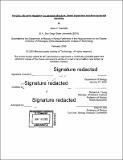| dc.contributor.advisor | Richard A. Young. | en_US |
| dc.contributor.author | Zamudio, Alicia V.(Alicia Viridiana Zamudio Monters de Oca) | en_US |
| dc.contributor.other | Massachusetts Institute of Technology. Department of Biology. | en_US |
| dc.date.accessioned | 2020-10-18T21:31:44Z | |
| dc.date.available | 2020-10-18T21:31:44Z | |
| dc.date.copyright | 2020 | en_US |
| dc.date.issued | 2020 | en_US |
| dc.identifier.uri | https://hdl.handle.net/1721.1/128064 | |
| dc.description | Thesis: Ph. D., Massachusetts Institute of Technology, Department of Biology, 2020 | en_US |
| dc.description | Cataloged from PDF of thesis. | en_US |
| dc.description | Includes bibliographical references. | en_US |
| dc.description.abstract | Proper regulation of gene expression is essential to the developmental processes that give rise to hundreds of different cell types with unique cellular identities. Regulation of protein-coding and long non-coding RNA genes by RNA polymerase II is carried out by the coordinated action of transcription factors and cofactors. Transcription factors can be cell-type specific and bind cell-type specific gene regulatory regions called enhancers, which can be located far upstream or downstream from the gene they activate. The enhancer-bound factors can loop to the promoters of cell-type specific genes to enhance the levels of transcription of these genes, and studies described in this thesis have provided new insights into the factors that contribute to this looping process (Weintraub et al., 2017). Recent studies have revealed that super-enhancers, which contribute to regulation of genes with prominent roles in cell identity, form phase-separated condensates that compartmentalize and concentrate the transcription apparatus at these genes. This insight led us to test the idea that signaling factors, which bring information regarding the developmental environment of cells to the transcription apparatus, might preferentially interact with super-enhancers through condensate interactions that were not considered in previous studies of signaling. Our studies confirmed that super-enhancer condensate do indeed facilitate the preferential localization of signaling factors to genes with prominent roles in cell identity (Zamudio et al., 2019). Thus, the studies described in this thesis provide new insights into gene regulation by genome structuring, phase separation and developmental signaling. | en_US |
| dc.description.statementofresponsibility | by Alicia V. Zamudio. | en_US |
| dc.format.extent | 191 pages | en_US |
| dc.language.iso | eng | en_US |
| dc.publisher | Massachusetts Institute of Technology | en_US |
| dc.rights | MIT theses may be protected by copyright. Please reuse MIT thesis content according to the MIT Libraries Permissions Policy, which is available through the URL provided. | en_US |
| dc.rights.uri | http://dspace.mit.edu/handle/1721.1/7582 | en_US |
| dc.subject | Biology. | en_US |
| dc.title | Insights into gene regulation by genome structure, phase separation and developmental signaling | en_US |
| dc.type | Thesis | en_US |
| dc.description.degree | Ph. D. | en_US |
| dc.contributor.department | Massachusetts Institute of Technology. Department of Biology | en_US |
| dc.identifier.oclc | 1199073234 | en_US |
| dc.description.collection | Ph.D. Massachusetts Institute of Technology, Department of Biology | en_US |
| dspace.imported | 2020-10-18T21:31:36Z | en_US |
| mit.thesis.degree | Doctoral | en_US |
| mit.thesis.department | Bio | en_US |
